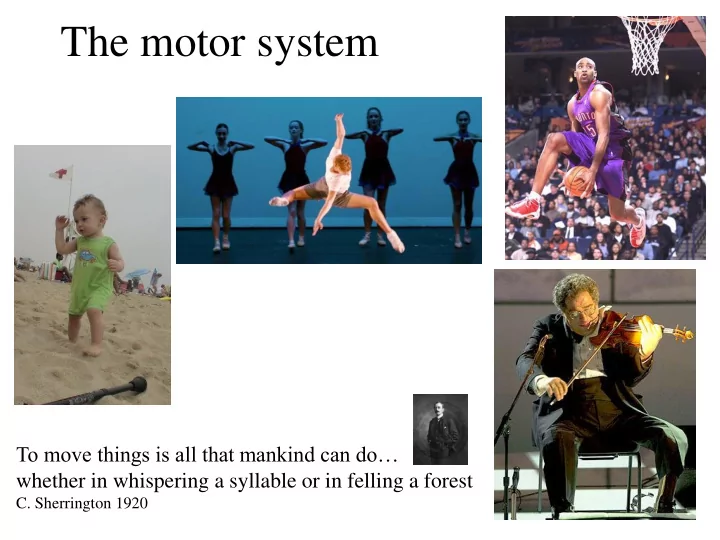

The motor system To move things is all that mankind can do… whether in whispering a syllable or in felling a forest C. Sherrington 1920
• Principles • Components: Muscles, Spinal cord and spinal tracts, Subcortical areas, Cortical fields. • Learning and plasticity
Three main types of movements • Reflex • Rhythmic • Voluntary
• Reflex : involuntary coordinated patterns of muscle contraction and relaxation elicited by peripheral stimuli (~40ms) Noxious stimuli excites ipsilateral flexor, and excites contralateral extensor Stretch reflex: contraction of same and synergist and relaxation of anatgonist
Rhythmic: Chewing, swallowing, and scratching, quadrupedal locomotion. • The spinal cord and brain stem. • Triggered by peripheral stimuli that activate the underlying circuits.
CPG: central pattern generators
Voluntary movements: principles Goal directed Reaching (~120 ms)
Feedback control (error correction) 1. Gain Vision Proprioception 2. Delay (phase lag)
Feed-forward (open loop) 1. Very hard computationally
Feedback control (error correction) Feedforward (open loop) Notice onset of muscles
Improve with practice • Co-contraction of muscles • Internal models : a neural representation of the relationship between the hand and the environment (how the arm would respond to the neural command).
Inverse and forward internal models An internal model is used either: - to predict the movement consequences of a motor commands ( forward model ). - to determine the motor commands needed to achieve a desired movement trajectory ( inverse model ).
Motor programs and Invariants Motor equivalence (Donald Hebb, 1950)
Pre-planning in vectors Is there online visual feedback? No - scaling of acceleration and speed Invariant time (Isochrony)
Kinematic transformation: to transform a target position into a command to the skeletal system to move the hand i.e. to convert between coordinate systems; Dynamic transformation: relate motor commands to the motion of the system; in the reaching task here considered, the forces applied changed the system without changing the kinematics.
Building blocks – segmentation - primitives Isogony (equal angles) Isochrony (duration independent of length) 2/3 power law: speed as a function of curvature
Designing a complex trajectory with limitations • Antagonistic muscles • Equilibrium point trajectory Emilio Bizzi
Stable behavioral gestures Graziano MS
Speed – accuracy tradeoff (Woodsworth, 1890) Variability/noise of the components (neurons! much more than muscles) Less time for feedback corrections? No, even without sensory feedback
Overcoming noise: optimization principles • Minimum jerk (smooth acceleration) • Minimum signal-dependent noise • Optimal control: minimize only what is relevant, and ignore other variables.
Hierarchical organization • Cortex • Basal-ganglia, cerebellum • Brain stem • Spinal tracts • Spinal cord • Muscles
Muscles 1. smooth muscles 2. cardiac muscles 3. skeletal muscles
Structure Muscle fiber myofibril Sarcomere: functional unit
The “engine” Sacroplasmic reticulum Cross bridges ->
Force depends on length Deformation + overlap
Force depends also on velocity
The force of a single muscle fiber is a function of Twitch • Stimulation rate • Stimulation pattern • The muscle length Unfused tetanus • The velocity of contraction • The fiber type • The fiber organization Fused tetanus • The duration of exercise - fatigue
Motor unit: motor neuron and the muscle fibers it innervates ( one to many )
3 types of motor unit: Recruited by order of force (low to high)
Muscle proprioceptive organs Spindle: length Parallel Golgi tendon: tension Serial
The muscle spindles are sensitive to changes in length
Active range can be dynamically modulated
Golgi tendon organs are sensitive to the tension
Spinal cord, Brain stem and spinal tracts
Spinal cord 1. Local interneurons 2. Propriospinal (across segments) 3. Projection (to upper centers) 4. Motor neurons Motor nuclei : cell bodies of motor neurons that innervate a muscle. Medial nuclei are long across segments Lateral are shorter
Brain stem pathways Medial pathways (vestibulospinal, reticulospinal,tectospinal), terminates in ventromedial (axial) for postural control. Lateral pathways (rubrospinal) terminates in dorsolateral.
The corticospinal tract
Modulation by task and descending pathways
Cortex and control of voluntary movement
Somato-topical organization
Stimulation in M1 Electrical and magnetic stimulation Lowest intensity Twitch in single muscle/joint Large (Betz) cells in lamina V Many locations -> same muscle Location - > several muscles
Cortical inputs
Neurons can be context-dependent
Premotor areas Premotor dorsal (PMd), premotor ventral (PMv), supplementary motor area (SMA), cingulate (CMA) – Multi-joint representation – Complex, meaningful – Sensorimotor transformations – Preparatory (set) activity – Bimanual coordination (SMA) – Sequence learning (SMA) – Self-initiation (PMv, SMA) vs. cue-driven (PMd) – Language, theory of mind
The basal Ganglia
Cortico loops
Action - Selection Direct pathway: facilitates movement. Indirect pathway: inhibits movement.
Parkinson and Dopamine Loss of dopaminergic input leads to increase in the indirect and decrease in the direct pathway => increase GPi => inhibition =? Hypokinesia
Treatment: pallidotomy or DBS
Recommend
More recommend